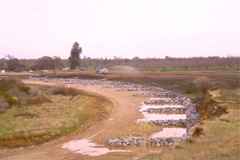The Use of Bendway Weirs and
Longitudinal Peaked Stone Toe Protection for Streambank Stabilization
Authors: John McCullah, CPESC, and Doug Hanford,
CPESC
ABSTRACT
 Project at completion |
Project in January 2002 |
This paper describes the first Bendway Weir project to be implemented in California. The Bendway Weir concept was developed by the Waterways Experiment Station (WES) in 1988 as a solution to a number of environmental and navigational problems caused by river bends (bendways) along two reaches of the Mississippi River. Performance there has been impressive. Since 1992, Bendway Weirs have been used on various sized rivers and streams in several areas of the country. The Bendway Weir and Longitudinal Peaked Stone Toe Protection (LPSTP) system was chosen for Buckeye Creek because of its proven efficacy in similar situations. John McCullah, erosion control consultant, David Derrick, hydraulic engineer, and Doug Hanford, soil bioengineering contractor, designed the streambank stabilization and erosion control components of this project.
Buckeye Creek is an ephemeral stream in Northern California that abuts a closed disposal site, the Dunnigan Burn Dump. Due to high flows in Buckeye Creek and extreme erosion from winter storms, burn ash and solid waste were being exposed along approximately 500 feet of the creek and carried downstream during periods of high water. Bendway Weirs were utilized in this remediation project to deflect the high-energy streamflows away from the exposed streambanks. Thirteen weirs and over 700 meters (2,300 ft) of LPSTP was installed along the exposed bank to reduce the possibility of undercutting and future exposure of the waste material. Construction and material costs were significantly less than more traditional methods such as gabions and rock riprap. Concern for wildlife habitat and other environmental issues prompted the use of soil bioengineering techniques. One of the traditional benchmarks of soil bioengineering is to use the resources that the site provides you. This project site had severe limitations, with lack of moisture in the soil to successfully vegetate with live materials collected on site at the time of construction, and lack of funds to provide water or maintenance for container plants. However, native and indigenous plant materials were available immediately adjacent to the site, and these were used to construct Composite Brush Siltation Weirs (CBSW’s), a suitable biotechnical practice for this site. This practice utilizes non-living material to initially dissipate the force of water until live plants can establish within this matrix.
E-mail: info@salixaec.com

© Salix Applied Earthcare